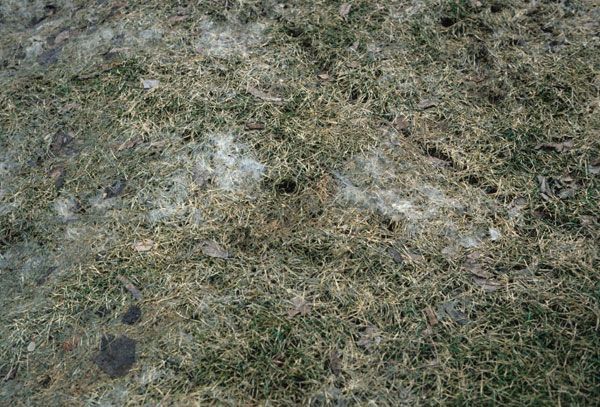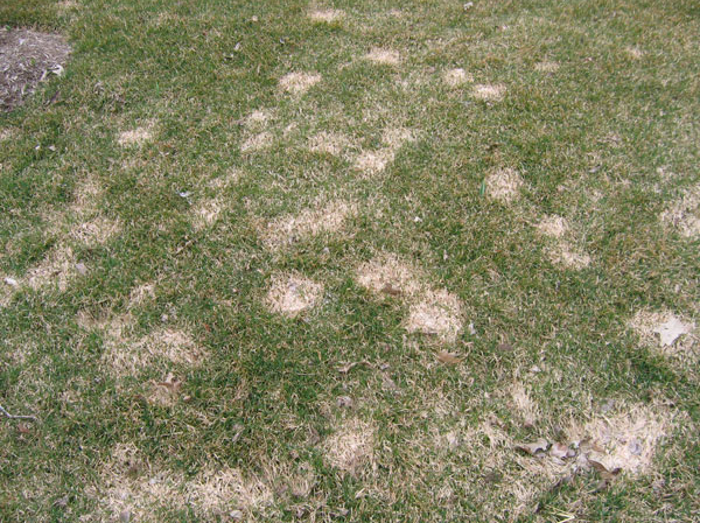Snow mold is a fungal disease that appears in early spring as the snow melts. There are two types of snow molds, gray and pink. They both become active under the snow cover. Gray snow mold (also called Typhula blight) is caused by Typhula spp., while pink snow mold (also called Fusarium patch) is caused by Microdochium nivalis.
- Gray snow mold survives hot summer temperatures in the soil or in infected plant debris
- Pink snow mold survives as mycelium or spores in infected plant debris.

Gray snow mold courtesy of UofMN Ext.
Symptoms
Symptoms first appear in the lawn as circular, straw-colored patches when the snow melts in spring.
- These patches continue to enlarge if the grass remains cold and wet.
- Grass within the patch often has a matted appearance and colored fungal growth.
- The fungal growth may cover the entire patch or develop along the margins, with gray snow mold being white to gray in color and pink snow mold being white to pink in sunlight.
- Occasionally, fungal fruiting bodies (mushrooms) may be seen emerging from infected turf.
- Hard structures, called sclerotia, may also develop on the leaves and crowns of plants infected by gray snow mold, not pink.

Pink Snow mold courtesy of UofMN Ext.
Snow molds do not occur in the home lawn every year, but are most common during years when an early, deep snow cover prevents the ground from freezing. A cold, open winter will not promote snow mold, but may cause winter injury. The damage caused by snow molds is seldom serious.
Treating
Treating snow molds in Spring is very different depending on which type of mold you have.
- For Pink Snow mold, treat the area with a fungicide. Fertilome F-Stop or Bonide Infuse (granular formula) both work well.
- For Gray Snow Mold gently rake affected areas of the lawn to promote drying and prevent further growth. Fungicides are not typically recommended.
Prevent
Prevent snow mold using the following steps.
- Avoid excessive applications of nitrogen fertilizer in the fall.
- Continue to mow the lawn at the recommended height until it is no longer actively growing. The taller the grass, the more likely it will mat down and encourage snow mold development.
- Rake up leaves in the fall.
- Manage the thatch layer to avoid accumulations of more than ½ inch.
- Spread out large snow piles to encourage rapid melting.
- Use snow fencing to minimize snow accumulation in problem spots.
To keep your lawn thick and green all season long, use Gertens 4-Step Lawn Fertilizer Program. From crabgrass busting in early spring to weeding & feeding in May and June plus late season recovery treatments and winterizing - Gertens 4-Step treatment plan is a proven system for maintaining a healthy and beautiful lawn.
The experts at Gertens are always available to answer your questions!

